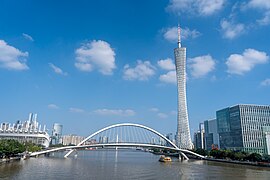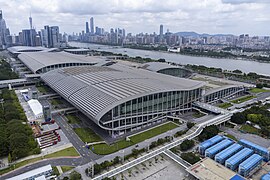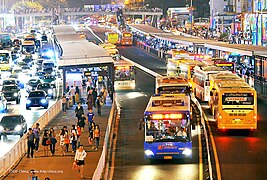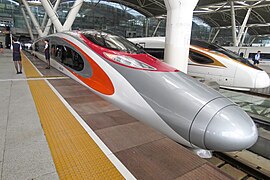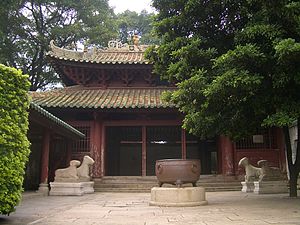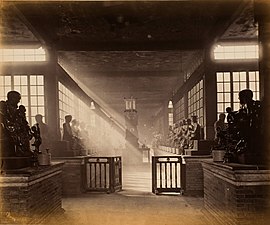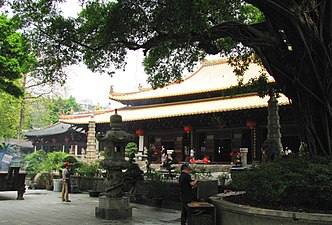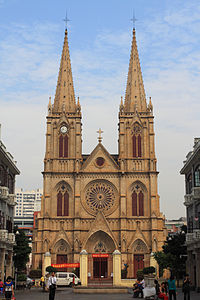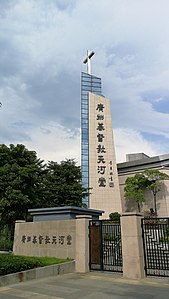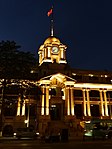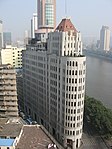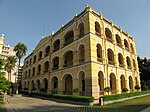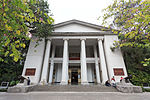Guangzhou
Guangzhou
广州 Canton; Kwangchow | |
|---|---|
Cantonese, Standard Chinese | |
| Website | gz.gov.cn |
| Guangzhou | ||||||||||||||||||||||||||
|---|---|---|---|---|---|---|---|---|---|---|---|---|---|---|---|---|---|---|---|---|---|---|---|---|---|---|
Hanyu Pinyin | ⓘ | |||||||||||||||||||||||||
| Cantonese Yale | ⓘ | |||||||||||||||||||||||||
Hanyu Pinyin | Suì | |||||||||||||||||||||||||
| Cantonese Yale | Seuih | |||||||||||||||||||||||||
| ||||||||||||||||||||||||||
Guangzhou[a] is the capital and largest city of Guangdong province in southern China.[8] Located on the Pearl River about 120 km (75 mi) north-northwest of Hong Kong and 145 km (90 mi) north of Macau, Guangzhou has a history of over 2,200 years and was a major terminus of the Silk Road.[9]
The port of Guangzhou serves as transportation hub and Guangzhou is one of China's three largest cities.[10] For a long time it was the only Chinese port accessible to most foreign traders. Guangzhou was captured by the British during the First Opium War and no longer enjoyed a monopoly after the war; consequently it lost trade to other ports such as Hong Kong and Shanghai, but continued to serve as a major Entrepôt. Due to a high urban population and large volumes of port traffic, Guangzhou is classified as a Large-Port Megacity, the largest type of port city in the world. Following the Second Battle of Chuenpi in 1841, the Treaty of Nanking was signed between Sir Robert Peel on behalf of Queen Victoria and Lin Zexu on behalf of Emperor Xuanzong and has ceded Hong Kong to the United Kingdom on 26 January 1841 after the agreement of the Convention of Chuenpi.[11] Due to worldwide travel restrictions at the beginning of the COVID-19 pandemic, Guangzhou Baiyun International Airport, the major airport of Guangzhou, briefly became the world's busiest airport by passenger traffic in 2020.[12]
Guangzhou is at the heart of the
In modern commerce, Guangzhou is best known for its annual
Guangzhou is a major Asia-Pacific research and development hub with a high level of scientific research output, ranking 8th globally and 4th in the Asia-Pacific,[26] and is home to many of China's most prestigious universities, including Sun Yat-sen University, South China University of Technology, Jinan University, South China Normal University, South China Agricultural University, Guangzhou University, Southern Medical University, Guangdong University of Technology, Guangzhou Medical University, and Guangzhou University of Chinese Medicine.[27][28][29]
Toponymy
Guǎngzhōu is the official
means 'broad' or 'expansive'.Before acquiring its current name, the town was known as Panyu (Punyü;
The
) is usually taken as a simple reference to the area's fine greenery.The English name "Canton" derived from
History
Prehistory
A settlement now known as Nanwucheng was present in the area by 1100 BC.
Nanyue
Guangzhou, then known as Panyu, was founded on the eastern bank of the
Panyu was the seat of
Imperial China


Incorporated into the
Amid the
Shortly after the
Following the

In October 1646, the Longwu Emperor's brother, Zhu Yuyue fled by sea to Guangzhou, the last stronghold of the Ming empire. On December 11, he declared himself the Shaowu Emperor, borrowing his imperial regalia from local theater troupes.[91] He led a successful offense against his cousin Zhu Youlang but was deposed and executed on January 20, 1647, when the Ming turncoat Li Chengdong (李成棟) sacked the city on behalf of the Qing.[92]
The Qing became somewhat more receptive to foreign trade after gaining control of
In the 19th century, most of the city's buildings were still only one or two stories. However, there were notable exceptions such as the
The Canton System was maintained until the outbreak of the
The concession for the
Modern China
Revolutions
During the late Qing dynasty, Guangzhou was the site of revolutionary attempts such as the
Republic of China
After the assassination of
From 1923 to 1926 Sun and the Kuomintang (KMT) used the city as a base to prosecute a renewed revolution in China by conquering the warlords in the north. Although Sun was previously dependent on opportunistic warlords who hosted him in the city, with the leadership of Chiang Kai-shek, the KMT developed its own military power to serve its ambition. The Canton years saw the evolution of the KMT into a revolutionary movement with a strong military focus and ideological commitment, setting the tone of the KMT rule of China beyond 1927.
In 1924, the KMT made the momentous decision to ally with the Communist Party and the USSR. With Soviet help, KMT reorganized itself along the Leninist line and adopted a pro-labor and pro-peasant stance. The
After the death of Sun Yat-sen in 1925 the mood was changing in the party toward the communists. In August the left-wing KMT leader
Li was deposed during a war between Chiang and the
People's Republic of China
Amid the closing months before total Communist victory, Guangzhou briefly served as the capital of the Republican government. Guangzhou was captured on October 14, 1949. Amid a massive exodus to
The
The municipality was expanded in the year 2000, with
On 16 June 2022 an EF2 tornado struck the city, causing major power outages and knocking out power to the city's subway lines.[112][113][114]
-
The
-
An 1855 painting of the gallery of Tingqua, one of the most successful suppliers of "export paintings" for Guangzhou's foreign traders.
-
Tianjin and Beijingpermitted foreigners full access to Guangzhou's walled city
-
TheFlowery Pagoda at the Temple of the Six Banyan Treesin 1863
-
TheSacred Heart Cathedraltowering over the one- and two-story homes of old Guangzhou c. 1880
-
TheUS Navy's Dept of Navigation's 1920 map of "Canton"[115]
-
Whampoa Military Academyon 16 June 1924
-
The Guangzhou Bund in 1930, with rows of Tanka boats
-
A short film of Guangzhou in 1937
-
The People's Liberation Army entering Guangzhou on 14 October 1949
Geography

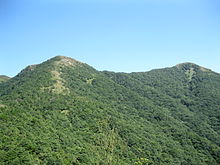
The old town of Guangzhou was near
The elevation of the prefecture generally increases from southwest to northeast, with mountains forming the backbone of the city and the ocean comprising the front.
Natural resources
There are 47 different types of minerals and also 820 ore fields in Guangzhou, including 18 large and medium-sized oil deposits. The major minerals are granite, cement limestone, ceramic clay, potassium, albite, salt mine, mirabilite, nepheline, syenite, fluorite, marble, mineral water, and geothermal mineral water. Since Guangzhou is located in the water-rich area of southern China, it has a wide water area with many rivers and water systems, accounting for 10% of the total land area. The rivers and streams improve the landscape and keep the ecological environment of the city stable.[119]
Water resources
The main characteristics of Guangzhou's water resources are that there are relatively few local water resources and relatively abundant transit water resources. The city's water area is 74,400 hectares, accounting for 10.05% of the city's land area. The main rivers include Beijiang, Dongjiang North Mainstream, Zengjiang, Liuxi River, Baini River, Pearl River Guangzhou Reach, Shiqiao Waterway, and Shawan Waterway. Beijiang, The Dongjiang River flows through Guangzhou City and merges with the Pearl River to flow into the sea. The local average total water resources is 7.979 billion cubic meters, including 7.881 billion cubic meters of surface water and 1.487 billion cubic meters of groundwater. Calculated based on the amount of local water resources and the permanent population counted in the sixth census in 2010, there are 1.0601 million cubic meters of water resources per square kilometer, with an average of 628 cubic meters per capita, which is one-half of the country's per capita water resources. The amount of water resources for transit passengers is 186.024 billion cubic meters, which is 23 times the total local water resources. The passenger water resources are mainly concentrated in the southern Wanghe District and Zengcheng District. The passenger water resources diverted from the Xijiang and Beijiang Rivers into Guangzhou City are 159.15 billion cubic meters, and the passenger water resources diverted from the Dongjiang River into the north mainstream of the Dongjiang River are 14.203 billion cubic meters. meters and the water inflow from the upper reaches of the Zengjiang River is 2.828 billion cubic meters. The southern river network area is in the tidal influence area, with large runoff and a strong tidal effect. The three major entrances of the Pearl River, Humen, Jiaomen, and Hongqili, enter the Lingding Ocean and exit the South China Sea in the south of Guangzhou City. The annual high tide volume is 271 billion cubic meters and the annual ebb tide volume is 408.8 billion cubic meters. The annual runoff of the three major entrances is 137.7 billion cubic meters. Compared with meters, the annual tide can bring a large amount of water, part of which is freshwater resources that can be utilized.[120]
Biological Resources
Cultivated crops in Guangzhou have the distinctive characteristics of the transition from the tropics to the subtropics, and it is one of the richest regions in China in terms of fruit tree resources, including three major categories of tropical, subtropical, and temperate zones, 41 families, 82 genera and 174 species, totaling more than 500 varieties (among which there are 55 major varieties of lychee). It is the center of origin and variety of lychee, longan, yellow skin, black (white) olive, and so on. Vegetables are known for their high quality and variety, with 15 major categories, 127 species, and more than 370 varieties. Flowers include fresh cut flowers (fresh cut flowers, fresh cut leaves, fresh cut branches), potted plants (potted flowers, bonsai, flower bed plants), ornamental seedlings, edible and medicinal flowers, industrial and other uses of flowers, lawns, seedlings, etc. More than 3,000 traditional varieties and in recent years the introduction of new varieties, development, and utilization. Grain, cash crops, livestock, poultry, aquatic products, wild animals, and a wide variety of famous and excellent varieties, including Zengcheng Simiao rice is the first protected variety in Guangzhou City to obtain geographical indications.[121]
Mineral Resources
The geological structure of Guangzhou City is quite complex, with good conditions for mineralization. Forty-seven kinds of minerals (including subspecies) have been discovered, with 820 mineral sites and 25 large and medium-sized mining areas. The main minerals are granite for construction, limestone for cement, ceramic clay, potassium, sodium feldspar, salt mines, manganese, nepheline orthoclase, fluorite, marble, mineral water, and thermal mineral water. Energy minerals and non-ferrous minerals in the area are in short supply, sporadically distributed, small in scale, and unstable in grade.[121] ,
Climate
Despite being located just south of the
| Climate data for Guangzhou (1991–2020 normals, extremes 1951–2010) | |||||||||||||
|---|---|---|---|---|---|---|---|---|---|---|---|---|---|
| Month | Jan | Feb | Mar | Apr | May | Jun | Jul | Aug | Sep | Oct | Nov | Dec | Year |
| Record high °C (°F) | 28.4 (83.1) |
29.4 (84.9) |
32.1 (89.8) |
33.3 (91.9) |
39.4 (102.9) |
38.9 (102.0) |
39.1 (102.4) |
38.3 (100.9) |
37.6 (99.7) |
36.2 (97.2) |
33.4 (92.1) |
29.6 (85.3) |
39.4 (102.9) |
| Mean daily maximum °C (°F) | 18.7 (65.7) |
20.0 (68.0) |
22.3 (72.1) |
26.4 (79.5) |
30.0 (86.0) |
32.0 (89.6) |
33.3 (91.9) |
33.2 (91.8) |
32.0 (89.6) |
29.3 (84.7) |
25.3 (77.5) |
20.7 (69.3) |
26.9 (80.5) |
| Daily mean °C (°F) | 13.8 (56.8) |
15.5 (59.9) |
18.3 (64.9) |
22.5 (72.5) |
26.0 (78.8) |
27.9 (82.2) |
28.9 (84.0) |
28.6 (83.5) |
27.4 (81.3) |
24.4 (75.9) |
20.2 (68.4) |
15.4 (59.7) |
22.4 (72.3) |
| Mean daily minimum °C (°F) | 10.6 (51.1) |
12.5 (54.5) |
15.5 (59.9) |
19.6 (67.3) |
23.1 (73.6) |
25.1 (77.2) |
25.8 (78.4) |
25.5 (77.9) |
24.2 (75.6) |
20.9 (69.6) |
16.7 (62.1) |
11.9 (53.4) |
19.3 (66.7) |
| Record low °C (°F) | 0.1 (32.2) |
1.3 (34.3) |
3.2 (37.8) |
7.7 (45.9) |
14.6 (58.3) |
18.8 (65.8) |
21.6 (70.9) |
20.9 (69.6) |
15.5 (59.9) |
9.5 (49.1) |
4.9 (40.8) |
0.0 (32.0) |
0.0 (32.0) |
| Average precipitation mm (inches) | 51.1 (2.01) |
56.1 (2.21) |
101.0 (3.98) |
193.8 (7.63) |
329.0 (12.95) |
364.9 (14.37) |
242.6 (9.55) |
270.3 (10.64) |
203.2 (8.00) |
67.3 (2.65) |
37.4 (1.47) |
33.4 (1.31) |
1,950.1 (76.77) |
| Average precipitation days (≥ 0.1 mm) | 7.2 | 9.4 | 13.8 | 15.3 | 17.4 | 19.4 | 17.0 | 16.8 | 12.0 | 5.7 | 5.7 | 5.7 | 145.4 |
| Average relative humidity (%)
|
72 | 76 | 80 | 82 | 81 | 82 | 79 | 80 | 77 | 70 | 69 | 67 | 76 |
| Mean monthly sunshine hours | 112.9 | 77.5 | 61.6 | 69.1 | 103.4 | 127.5 | 179.0 | 166.4 | 167.0 | 182.2 | 159.7 | 152.7 | 1,559 |
| Percent possible sunshine | 33 | 24 | 17 | 18 | 25 | 32 | 43 | 42 | 46 | 51 | 49 | 46 | 36 |
| Source: China Meteorological Data Service Center [125][126][127] all-time extreme temperature[123] | |||||||||||||
Administrative divisions
Guangzhou is a
|
|
| ||||||||||||||||||||||||||||||||||||||||||||||||||||||||||||||||||||||||||||||||||||||||||||||||||||||||||||||||||||||||||||||||||||||||||||||||
| |||||||||||||||||||||||||||||||||||||||||||||||||||||||||||||||||||||||||||||||||||||||||||||||||||||||||||||||||||||||||||||||||||||||||||||||||
Economy
Guangzhou is the main manufacturing hub of the
Zhujiang New Town
-
Zhujiang New Town
-
Skyscrapers in Zhujiang New Town
-
Skyscrapers in Zhujiang New Town
-
Haixin Bridge and Canton Tower near Zhujiang New Town
-
Zhujiang New Town at night
Canton Fair
The
-
The firstSovietFriendship Building
-
The former Canton Fair site atYuexiu's Liuhua Complex
-
The new Canton Fair Complex
-
Interior of the Canton Fair Complex
Local products
This section needs additional citations for verification. (June 2016) |
- Cantonese cuisine is one of China's most famous and popular regional cuisines, with a saying stating simply to "Eat in Guangzhou" (食在廣州).
- Cantonese .
- Canton porcelain developed over the past three centuries as one of the major forms of exportware. It is now known within China for its highly colorful style.
- Cantonese embroidery is one of china's four main styles of the embroidery.
- Zhujiang Beer, a pale lager, is one of China's most successful brands.
Industry

- GAC Group
- Guangzhou Economic and Technological Development Zone
- Guangzhou Nansha Export Processing Zone
- The Export Processing Zone was founded in 2005. Its total planned area is 1.36 km2 (0.53 sq mi).[137] It is located in Nansha District and it belongs to the provincial capital, Guangzhou. The major industries encouraged in the zone include automobile assembly, biotechnology and heavy industry. It is situated 54 km (34 mi) (a 70 minutes drive) south of Guangzhou Baiyun International Airport and close to Nansha Port. It also has the advantage of Guangzhou Metro line 4 which is being extended to Nansha Ferry Terminal.
- Guangzhou Free Trade Zone
- The zone was founded in 1992. It is located in the east of Huangpu District and near to Guangzhou Economic and Technological Development Zone. It is also very close to Guangzhou Baiyun Airport.[138] The major industries encouraged in the zone include international trade, logistics, processing and computer software. Recently the Area has been rebranded and is now being marketed under the name Huangpu District. Next to the industries above, new sectors are being introduced to the business environment, including new energy, AI, new mobility, new materials, information and communication technology and new transport. It is also home to the Guangzhou IP Court.[139]
- The zone was founded in 1992. It is located in the east of
- Guangzhou Science City
Business Environment
Guangzhou is a hub for international businesses. According to an article by China Briefing, over 30,000 foreign-invested companies had settled in Guangzhou by 2018, including 297 Fortune Global 500 companies with projects and 120 Fortune Global 500 companies with headquarters or regional headquarters in the city.[140]
Demographics
| Year | Pop. | ±% |
|---|---|---|
| 1950[141] | 2,567,645 | — |
| 1960[141] | 3,683,104 | +43.4% |
| 1970[141] | 4,185,363 | +13.6% |
| 1980[141] | 5,018,638 | +19.9% |
| 1990[141] | 5,942,534 | +18.4% |
| 2000[141] | 9,943,000 | +67.3% |
| 2002[142] | 10,106,229 | +1.6% |
| 2005[143] | 9,496,800 | −6.0% |
| 2006[143] | 9,966,600 | +4.9% |
| 2007[143] | 10,530,100 | +5.7% |
| 2008[143] | 11,153,400 | +5.9% |
| 2009[143] | 11,869,700 | +6.4% |
| 2010[141] | 12,701,948 | +7.0% |
| 2011[144] | 12,751,400 | +0.4% |
| 2012[144] | 12,832,900 | +0.6% |
| 2013[144] | 12,926,800 | +0.7% |
| 2014[144] | 13,080,500 | +1.2% |
| 2018 | 14,904,400 | +13.9% |
| Population size may be affected by changes to administrative divisions. | ||
The
Ethnicity and language
Most of Guangzhou's population is
Guangzhou also possesses a large resident population who are
Recent years have seen a huge influx of migrants, with up to 30 million additional migrants living in the Guangzhou area for at least six months out of every year with the majority being female migrants and many becoming local Guangzhou people. This huge influx of people from other areas, called the floating population, is due to the city's fast-growing economy and high labor demands. Guangzhou Mayor Wan Qingliang told an urban planning seminar that Guangzhou is facing a very serious population problem stating that, while the city had 10.33 million registered residents at the time with targets and scales of land use based on this number, the city actually had a population with migrants of nearly 15 million. According to the Guangzhou Academy of Social Sciences researcher Peng Peng, the city is almost at its maximum capacity of just 15 million, which means the city is facing a great strain, mostly due to a high population of unregistered people.[156]
According to the 2000 National Census, marriage is one of the top two reasons for permanent migration and is particularly important for women as 29.3% of the permanent female migrants migrate for marriage [Liang et al.,2004]. Many of the female economic migrants marry men from Guangzhou in hopes of a better life.
Historically, the Cantonese people have made up a sizable part of the 19th- and 20th-century
Demographically, the only significant immigration into China has been by
Metropolitan area
The encompassing metropolitan area was estimated by the OECD (Organization for Economic Cooperation and Development) to have, as of 2010[update], a population of 25 million.[167][168]
Development of Guangzhou
ScienceDirect provides a report on their website of the development of Guangzhou from 1990 until 2020, showing how in 1990, the developed residential districts were almost exclusively concentrated in a small part of western Guangzhou whereas other parts of Guangzhou had a smaller limited amount of developed residential communities being overwhelmingly surrounded by agricultural and forest lands. However, from 2005 until 2020, other parts of the city eventually began to develop more so residential communities and in the 2020 map report, it showed fully developed residential communities going from west to east of the city whereas the very southern part and large portions of northern Guangzhou still remain mainly agricultural and forest lands with very limited developed residential communities.[169][170]
Transportation
Urban mass transit

When the first line of the
The
Motor transport

In the 19th century, the city already had over 600 long, straight streets; these were mostly paved but still very narrow.[41] In June 1919, work began on demolishing the city wall to make way for wider streets and the development of tramways. The demolition took three years in total.[175]
In 2009, it was reported that all 9,424 buses and 17,695 taxis in Guangzhou would be operating on LPG-fuel by 2010 to promote clean energy for transport and improve the environment ahead of the 2010 Asian Games which were held in the city.[176] At present[when?], Guangzhou is the city that uses the most LPG-fueled vehicles in the world, and at the end of 2006, 6,500 buses and 16,000 taxis were using LPG, taking up 85 percent of all buses and taxis.[citation needed]
Effective January 1, 2007, the municipal government banned motorcycles in Guangdong's urban areas. Motorcycles found violating the ban are confiscated.[177] The Guangzhou traffic bureau claimed to have reported reduced traffic problems and accidents in the downtown area since the ban.[178]
Airports
Guangzhou's main airport is the
Guangzhou is served by Hong Kong International Airport; ticketed passengers can take ferries from the Lianhuashan Ferry Terminal and Nansha Ferry Port in Nansha District to the HKIA Skypier.[183] There are also coach bus services connecting Guangzhou with HKIA.[184]
Rail
Guangzhou is the terminus of the
Water transport
There are daily high-speed catamaran services between Nansha Ferry Terminal and Lianhua Shan Ferry Terminal in Guangzhou and the Hong Kong China Ferry Terminal, as well as between Nansha Ferry Terminal and Macau Ferry Pier in Hong Kong.
- Transport in Guangzhou
-
Trains used by the Guangzhou Metro
-
GBRTstation
-
Huadu District
-
Guangzhou South Railway Station
Culture

Guangzhou's culture is mainly
heritage include:- Cantonese language, the local and prestige variant of Yue Chinese.
- Cantonese cuisine, one of China's eight major culinary traditions.[187][note 1]
- Cantonese opera, usually divided into martial and literary performances.
- Xiguan (Saikwan), the area west of the former walled city.
The
It is worth noting that
In the Hakka people inhabited areas of Guangzhou, Hakka culture has been well developed and preserved, and in the long history, the integration of Canton culture and Hakka culture has derived new cultural characteristics. Zengcheng, Guangzhou is a district with a history of more than 1800 years, with the harmonious coexistence of Canton culture and Hakka culture, the derived food culture has not only the non-heritage food such as Zhengguo Wonton, Lanxi Rice Noodle, and Goose Soup, but also the special food such as Yuecun Dace Fish Skin, Paitan Roasted Chicken, and Shitan Whole Cattle Banquet.[189]
Religions
Before the postmodern era, Guangzhou had about 124 religious pavilions, halls, and temples.
Taoism
Buddhism
The temples were badly damaged by both the
Christianity
Islam
Guangzhou has had ties with the Islamic world since the
- Religious sites in Guangzhou
-
Guangzhou's Temple of the Five Immortals
-
The Hall of the 500 Arhats at the Flowery Forest Temple (Hualin) in the 1870s
-
Guangzhou's City God Temple
-
The sacred pigs of theOcean Banner Temple(Hoi Tong) in the 1830s
-
TheFlower Pagoda at the Temple of the Six Banyan Trees(Liurong)
-
The Thousand Buddha Tower at the present-day Hoi Tong Monastery
-
Sacred Heart Cathedral
-
Tianhe Church, built in 2017
Sports

The 11,468 seat Guangzhou Gymnasium was a 2019 FIBA Basketball World Cup venue.[198]
From November 12 to 27, 2010, Guangzhou hosted the

Guangzhou also hosted the following major sporting events:
- 1987 The 6th National Games of China
- 1991 The 1st FIFA Women's World Cup
- 2001 The 2001 National Games of China
- 2007 The 8th National Traditional Games of Ethnic Minorities of the People's Republic of China
- 2008 The 49th World Table Tennis Championships
- 2009 The 11th Sudirman Cup: the world badminton mixed team championships
Current professional sports clubs based in Guangzhou include:
| Sports | League | Tier | Club | Stadium |
|---|---|---|---|---|
Soccer
|
China League One | 2nd | Guangzhou | Huadu Stadium |
| Esports (Overwatch) | Overwatch League | 1st | Guangzhou Charge | Tianhe Gymnasium |
| Basketball | Chinese Basketball Association | 1st | Guangzhou Loong Lions | Tianhe Gymnasium |
| Baseball | China Baseball League | 1st | Guangdong Leopards | Tianhe Sports Center baseball field |

In the 2010s, Guangzhou became a Chinese soccer powerhouse, having won eight national titles between 2011 and 2019. The team has also won the AFC Champions League in 2013 and 2015. The club has competed at the 2013 and 2015 FIFA Club World Cup, where it lost 3–0 in the semifinal stage to the 2012–13 UEFA Champions League winners FC Bayern Munich and the 2014–15 UEFA Champions League winners FC Barcelona, respectively.[200]
Restaurants
In the 1990s the local press prolifically published reviews of restaurants in Guangzhou. The local newspapers introduced
Destinations
Eight Views

The
- "Towers Shining through the New Town"
- "The Pearl River Flowing and Shining": The
- "Cloudy Mountain Green and Tidy": Baiyun Mountain Scenic Area
- "Yuexiu's Grandeur": Park
- "The Ancient Academy's Lingering Fame": The Chen Clan Ancestral Hall and its folk art museum
- "Liwan's Wonderful Scenery": Liwan Lake
- "Science City, Splendid as Brocade"
- "Wetlands Singing at Night": Nansha Wetlands Park
Parks and gardens
- Baiyun Mountain
- Nansha Wetland Park
- People's Park
- South China Botanical Garden
- Yuexiu Park
- Guangdong Tree Park
- Dongshanhu Park (东山湖公园; 東山湖公園)
- Liuhuahu Park (流花湖公园; 流花湖公園)
- Liwanhu Park (荔湾湖公园; 荔灣湖公園)
- Luhu Park (麓湖公园; 麓湖公園)
- Martyrs' Park (广州起义烈士陵园; 廣州起義烈士陵園)
- Pearl River Park (珠江公园; 珠江公園)
- Yuntai Garden (云台花园; 雲臺花園)
- Shimen National Forest Park(石门国家森林公园; 石門國家森林公園)
- Haizhu Lake Park(海珠湖公园; 海珠湖公園)
Tourist attractions
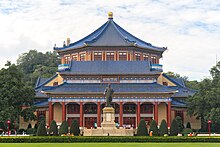
Guangzhou attracts more than 223 million visitors each year, and the total revenue of the tourism exceeded 400 billion in 2018.[203] There are many tourist attractions, including:
- Canton Tower
- Chen Clan Ancestral Hall, housing Guangzhou's folk art museum
- Chime-Long Paradise
- Chime-Long Waterpark (simplified Chinese: 长隆水上乐园; traditional Chinese: 長隆水上樂園)
- Guangdong Provincial Museum
- Guangzhou Zoo
- Mulberry Park, public center which demonstrates mulberry growing and silk making
- Museum of the Mausoleum of the Nanyue King
- Peasant Movement Training Institute, an important Maoist site
- Sacred Heart Cathedral(Stone House)
- Temple of Bright Filial Piety (Guangxiao)
- Temple of the Six Banyan Trees (Liurong), site of the Flowery Pagoda
- Sanyuan Palace
- Shamianor Shameen Island, the old trading compound
- Sun Yat-sen Memorial Hall, site of Guangzhou's former presidential palace
- Xiguan (Saikwan), the western suburbs of the old city
Pedestrian streets
In every district there are many shopping areas where people can walk on the sidewalks; however most of them are not set as pedestrian streets.
The popular pedestrian streets are:
- Beijing Road pedestrian street
- Shangxiajiu Pedestrian Street
- Huacheng Square (Flower City Square)
Malls and shopping centers
There are many malls and shopping centers in Guangzhou. The majority of the new malls are located in the Tianhe district.

- 101 Dynamics
- China Plaza
- Liwan Plaza
- Teem Plaza
- Victory Plaza
- Wanguo Plaza
- Grandview Mall (Grandview Mall Aquarium)
- Wanda square
- Happy Valley
- TaiKoo Hui
- Parc Central
- OneLinkWalk
- Rock Square
- Aeon Mall
- GT Land Plaza
- IFC Plaza
- IGC Mall
- Mall of the World
- K11
- Fashion Tianhe
Major buildings
- CITIC Plaza
- Canton Tower
- Guangzhou Circle Mansion
- Guangdong Olympic Stadium
- Guangzhou Opera House
- Guangzhou TV Tower
- Pearl River Tower
- The Twin Towers:
- Guangzhou International Finance Center (West)
- The CTF Guangzhou(East)
-
Canton Custom House (est. 1916), one of the oldest surviving in China
-
Aiqun Hotel, Guangzhou's tallest building from 1937 to 1967
-
Our Lady of Lourdes Chapel onShamian
-
The Canton Cement Factory (est. 1907), which housed Sun Yat-sen from 1923 to 1925
-
The old provincial capitol, now the Museum of Revolutionary History
Media
Guangzhou has two local radio stations: the provincial
Guangzhou has some of the most notable Chinese-language newspapers and magazines in
Education and research



The
As of June 2023, Guangzhou hosts 84 institutions of higher education (excluding adult colleges), ranking 2nd nationwide after Beijing and 1st in South China region.[205] The city has many highly ranked educational institutions, with seven universities listed in 147 National Key Universities under the Double First-Class Construction, ranking fourth nationwide (after Beijing, Shanghai and Nanjing). Guangzhou is also an important hub for international students and it was ranked 110th globally by the QS Best Student Cities Rankings in 2023.[206]
Guangzhou is a major Asia-Pacific R&D hub, ranking 8th globally, 4th in the Asia & Oceania regions after (Beijing, Shanghai and Nanjing) and 1st in South Central China region.[207]
The Guangzhou Higher Education Mega Center's higher education campuses are as follows:
- Guangdong Pharmaceutical University
- Guangdong University of Foreign Studies
- Guangdong University of Technology
- Guangzhou Academy of Fine Arts
- Guangzhou University
- Guangzhou University of Chinese Medicine
- South China Normal University
- South China University of Technology
- Sun Yat-sen University
- Xinghai Conservatory of Music
Guangzhou's other fully accredited and degree-granting universities and colleges include:
- Guangdong Institute of Science and Technology
- Guangdong Polytechnic Normal University
- Guangdong University of Finance & Economics
- Guangdong University of Finance
- Guangzhou College of South China University of Technology
- Guangzhou Medical University
- Guangzhou Sports University
- Jinan University
- South China Agricultural University
- Southern Medical University
- Zhongkai University of Agriculture and Engineering
The two main comprehensive libraries are Guangzhou Library and Sun Yat-sen Library of Guangdong Province. Guangzhou Library is a public library in Guangzhou. The library has moved to a new building in Zhujiang New Town, which fully opened on June 23, 2013.[208] Sun Yat-sen Library of Guangdong Province has the largest collection of ancient books in Southern China.[209]
Notable people
- Choh Hao Li (1913–1987), American biochemist, expert on hormones
- Zhi Cong Li (born 1993), racing driver
- Xiao Ping Liang (born 1959), internationally exhibited calligrapher
- Kuang Sunmou (1863–?), railway engineer, businessman, and bureaucrat
- Bolo Yeung (born July 3, 1946), Hong Kong martial artist, competitive bodybuilder, and film actor
- Qi Yuwu (born November 28, 1976), actor based in Singapore
- Donnie Yen (born 27 July 1963), Hong Kong martial artist, action director and choreographer, and film director and actor
International relations
Twin towns and sister cities
Consulates General/consulates
As of April 2023, Guangzhou hosts 68 foreign consulates-general/consulates, excluding the Hong Kong and Macao trade office, making it one of the major cities to host more than 50 foreign representatives in China after Beijing and Shanghai.[23][24]
See also
- Canton System and Old China Trade
- World's largest cities
- Historical capitals of China
- Mezitli Producer Women's Market#Guangzhou Innovation Award
- 2021 Guangzhou bombing
Notes
- ^
- UK: /ɡwæŋˈdʒoʊ/, gwang-JOH,[4] US: /ˈɡwɑːŋ-/, GWAHNG-[5]
- Chinese: 广州; pinyin: Guǎngzhōu
- Cantonese: [kʷɔ̌ːŋ.tsɐ̂u] or [kʷɔ̌ːŋ.tsɐ́u] ⓘ
- alternatively as Canton[6] or Kwangchow[7]
References
- ^ 土地面积、人口密度(2008年). Statistics Bureau of Guangzhou. Archived from the original on March 23, 2015. Retrieved February 8, 2010.
- ^ a b "China: Guăngdōng (Prefectures, Cities, Districts and Counties)". City Population. Archived from the original on June 29, 2020. Retrieved September 19, 2021.
- ^ "2021年广州Gdp达28231.97亿元 同比增8.1%-中新网". Archived from the original on January 26, 2022. Retrieved January 26, 2022.
- ^ "Guangzhou". Lexico UK English Dictionary. Oxford University Press. Archived from the original on September 28, 2020.
- ^ "Guangzhou". Merriam-Webster.com Dictionary.
- ^ "Canton". Lexico UK English Dictionary UK English Dictionary. Oxford University Press. Archived from the original on August 14, 2020.
- ^ "Guangzhou". Encyclopædia Britannica. Encyclopædia Britannica, Inc. Archived from the original on March 21, 2019. Retrieved April 27, 2019.
- ^ "Illuminating China's Provinces, Municipalities and Autonomous Regions". PRC Central Government Official Website. Archived from the original on June 19, 2014. Retrieved May 17, 2014.
- ^ 海上丝绸之路的三大著名港口. People.cn. Archived from the original on June 3, 2016. Retrieved May 20, 2014.
- ^ a b c d "Tourism Administration of Guangzhou Municipality". visitgz.com. Archived from the original on September 6, 2010. Retrieved March 21, 2010.
- .
- ^ Kenji Kawase (January 25, 2021). "China's Guangzhou airport crowns itself the world's busiest for 2020". Nikkei Asia. Retrieved February 14, 2021.
- ^ "Major Agglomerations of the World". City Population. Archived from the original on June 12, 2018. Retrieved January 18, 2021.
- ^ 中央机构编制委员会印发《关于副省级市若干问题的意见》的通知. 中编发[1995]5号. docin.com. February 19, 1995. Archived from the original on May 29, 2014. Retrieved May 28, 2014.
- ^ 全国乡镇规划确定五大中心城市. Southern Metropolitan Daily. February 9, 2010. Archived from the original on July 31, 2013. Retrieved July 29, 2010.
- S2CID 149595200.
- ^ Cheng, Andrew; Geng, Xiao (April 6, 2017). "Unlocking the potential of Chinese cities". China Daily. Archived from the original on September 28, 2017. Retrieved September 28, 2017.
- ^ "Top 10 Chinese cities by urban resident population". China Daily. November 18, 2022. Retrieved November 26, 2022.
- S2CID 153995277.
- ^ "Guangzhou tops best mainland commercial cities rankings". chinadaily. December 16, 2014. Archived from the original on August 24, 2016. Retrieved February 1, 2016.
- ^ "GaWC - The World According to GaWC 2020". www.lboro.ac.uk. Retrieved June 12, 2022.
- ^ a b "The Global Financial Centres Index 28" (PDF). Long Finance. September 2020. Archived (PDF) from the original on January 18, 2021. Retrieved September 26, 2020.
- ^ a b "Consulates in Guangzhou, China". www.embassypages.com. Archived from the original on January 18, 2021. Retrieved November 9, 2020.
- ^ a b "CHINA EMBASSIES & CONSULATES". www.embassypages.com. Archived from the original on July 11, 2019. Retrieved November 9, 2020.
- ^ a b "Shimao Shenkong International Center·Hurun Global Rich List 2020". Hurun Report. February 26, 2020. Archived from the original on December 21, 2020. Retrieved January 18, 2021.
- ^ "Leading 200 science cities Nature Index 2023 Science Cities Supplements". www.nature.com. Retrieved November 22, 2023.
- ^ "Nature Index 2018 Science Cities". Nature Index. Archived from the original on October 2, 2020. Retrieved September 22, 2020.
- ^ "ShanghaiRanking's Best Chinese Universities Ranking". ShanghaiRanking. Archived from the original on August 16, 2021. Retrieved August 16, 2021.
- ^ "US News Best Global Universities Rankings in Guangzhou". U.S. News & World Report. October 26, 2021. Archived from the original on October 30, 2021. Retrieved October 30, 2021.
- ^ 番禺求证.[permanent dead link]
- ^ Xu, Jian (c. 720). 初學記 [Chuxueji, Records for Initial Studies] (in Traditional Chinese).
- ^ 中国古今地名大词典. Shanghai: Shanghai Cishu Press. 2005. p. 2901.
- ^ Yule, H. (1916). Cathay and the Way Thither. Vol. I. London: Hakluyt Society.
- ISBN 9789004144736.
- ISBN 9780252097096.
- ISBN 9781442215610.
- ^ The Chinese Repository. Vol. II (2nd ed.). Kraus. 1834.
- ^ Santa Barbara Portuguese Studies. Vol. I–II. Jorge de Sena Center for Portuguese Studies. 1994. p. 256.
- ^ T'ien Hsia Monthly. Vol. VII. Sun Yat-sen Institute. 1939. p. 426.
- ISBN 9780877798095.
- ^ a b c d e f g EB (1878), p. 37.
- ^ Short, John R. (1992), Human Settlement, Oxford: Oxford University Press, p. 212
- ^ Peter Haggett (ed.), Encyclopedia of World Geography, vol. 20: China and Taiwan, Marshall Cavendish, p. 2844
- ^ a b Gray (1875), p. 1–2
- ^ a b ACC (1845), p. 82
- ISBN 9780197576236.
- ^ Gray (1875), p. 3
- ^ Taylor, Keith Weller (1991), The Birth of Vietnam, Berkeley: University of California Press, p. 24
- ^ Yi Song-mi Erickson, Susan N.; Nylan, Michael (2010), "The Archaeology of the Outlying Lands", in Nylan-Loewe (ed.), China's Early Empires, p. 163
- ^ a b Yü (1987), p. 453.
- ISBN 9780071412797
- ^ 刘煦.旧唐书·王方庆传〔M〕.北京:中华书局,1975
- ^ 杜佑.通典, vol. 卷191〔M〕, Beijing: 中华书局, 1984
- ^ ISBN 9781138821309.
- ^ a b Bretschneider, E. (1871), On the Knowledge Possessed by the Ancient Chinese of the Arabs and Arabian Colonies and Other Western Countries, Mentioned in Chinese Books, Trübner & Co., p. 10
- ^ ISBN 9781568361345
- ^ a b Needham, Joseph (1954), Science & Civilisation in China, vol. I, Cambridge University Press, p. 179
- ^ a b Sima Guang. Zizhi Tongjian Comprehensive Mirror to Aid in Government.
- ^ a b Gabriel Ferrand, ed. (1922), Voyage du Marchand Arabe Sulaymân en Inde et en Chine, Rédigé en 851, suivi de Remarques par Abû Zayd Hasan (in French), p. 76
- ^ a b "Kaifung Jews", Overview of World Religions, University of Cumbria, archived from the original on October 28, 2008, retrieved August 30, 2009
- ^ a b أبوزيد حسن السيرافي ،"رحلة السيرافي"،المجمع الثقافي، أبو ظبي، عام 1999م (Abu Zayd Husayn al-Sirafi, Rihlat al-Sirafi, al-Mujamma' al-thaqafi, Abu Dhabi, 1990)
- ^ a b Abu Zayd as-Sirafi, رحلة السيرافي [The Journey of As-Sirafi] (in Arabic)
- ^ ISBN 9780195825930
- ^ Memoirs of the Research Department of the Toyo Bunko (Oriental Library), No. 2. Toyo Bunko. 1928. p. 34.
- .
- ^ Yule 2002, p. 121.
- ^ Dunn (1986), p. 259.
- ^ تحفة النظار في غرائب الأمصار وعجائب الأسفار,ابن بطوطة,ص 398
- ^ Von Glahn (1996), p. 90.
- ^ Li (2010), p. 3.
- ^ Von Glahn (1996), p. 116.
- ^ Von Glahn (1996), p. 91.
- ^ a b Knight's (1841), p. 135.
- ^ Cortesao (1944), p. xxxiv.
- ^ Wills (1998), p. 331.
- ^ Wills (1998), pp. 331–332.
- ^ a b Douglas (2006), p. 11.
- ^ a b Dutra & al. (1995), p. 426.
- ^ Wills (1998), pp. 337–338.
- ^ Cortesao (1944), p. xxxvii.
- ^ ISBN 9781118274026
- ^ Wills & al. (2010), p. 28.
- ^ Wills (1998), p. 339.
- ^ Cortesao (1944), p. xl, xliii.
- ^ Wills (1998), p. 340.
- ^ Cortesao (1944), p. xliv–v.
- ^ Wills (1998), p. 343.
- ^ Wills (1998), p. 343–344.
- ISBN 9780813337494
- ^ La Carpentier, Jean-Baptiste (1655), L'Ambassade de la Compagnie Orientale des Provinces Unies vers l'Empereur de la Chine Embassy of the United Provinces' East India Company to the Emperor of China (in French)
- ^ Wakeman (1985), p. 737.
- ^ Wakeman (1985), p. 738.
- ^ Perdue (2009).
- ^ a b c d Gunn (2011), p. 208.
- ^ Butel (1997), p. 197.
- OCLC 002094734
- ^ Kjellberg (1975), p. 99.
- ^ Van Dyke, Paul A. (2005), The Canton Trade—Life and Enterprise on the China Coast, 1700–1845, Hong Kong, p. 161
{{citation}}: CS1 maint: location missing publisher (link) - ^ Kjellberg (1975), p. 95.
- ^ Bulletins &c. (1841), p. 357.
- ^ MacPherson (1842), pp. 312 & 315.
- ^ John King Fairbank, Trade and Diplomacy on the China Coast: The Opening of the treaty ports, 1842–1854 (Harvard U. P.) pp 267-284
- ^ Johnathan Andrew Farris, Enclave to Urbanity: Canton, Foreigners, and Architecture from the Late Eighteenth to the Early Twentieth Centuries (2016)
- ^ Lee, En-han (1977), China's Quest for Railway Autonomy, 1904–1911: A Study of the Chinese Railway-Rights Recovery Movement, Singapore University Press
- ^ "Canton–Hankow Railway", The Sydney Morning Herald, June 9, 1936
- ISBN 9780419221609, archivedfrom the original on June 11, 2014, retrieved August 31, 2017
- ^ a b Beck (2007).
- ISBN 978-0-415-14571-8, archivedfrom the original on February 25, 2017, retrieved August 31, 2017
- ^ a b Ah Xiang (1998), "The Zhongshan Warship Incident" (PDF), Tragedy of Chinese Revolution, archived (PDF) from the original on April 15, 2012, retrieved July 13, 2016
- ^ 李洁之,陈济棠主粤始末,《广州文史》第三十七辑。
- ^ "Guangzhou and Foshan signed "City Merge Cooperation Framework"". News.xinhuanet.com. Archived from the original on July 5, 2009. Retrieved May 6, 2010.
- ^ "Awesome photo shows the nighttime monster heading for Guangzhou Metropolitan". Twitter. Retrieved June 19, 2022.
- ^ "Damage survey suggests that the Guangzhou tornado had EF2 peak strength and traveled 1.5 km during its 5-minute lifetime". Twitter. Retrieved June 19, 2022.
- ^ "Major damage after large tornado hits Guangzhou megalopolis – Guangdong, China". watchers.news. The Watchers. June 16, 2022. Retrieved June 20, 2022.
- ^ US Navy Ports of the World: Canton, Ditty Box Guide Book Series, US Bureau of Navigation, 1920, Canton
- ^ "The longest & largest rivers in China, Major rivers in China". topchinatravel.com. Archived from the original on July 25, 2018. Retrieved January 28, 2019.
- doi:10.1890/130260. Archived(PDF) from the original on December 7, 2021. Retrieved September 5, 2021.
- ^ "Baiyun Mountain Scenic Area". Baiyunshan.com.cn. Archived from the original on October 8, 2013. Retrieved September 11, 2013.
- ^ "Guangzhou International". english.gz.gov.cn. Archived from the original on November 9, 2016. Retrieved November 8, 2016.
- ^ The website of The People’s Government of Guangzhou Municipality. https://www.gz.gov.cn/m_index.html
- ^ a b The website of The Central People's Government of the P.R.China. https://www.gov.cn/xinwen/2022-07/11/content_5700427.htm#allContent
- ^ "Travel China Guide: Fascinating Guangzhou". Blogspot. August 12, 2008. Archived from the original on July 8, 2011. Retrieved August 21, 2008.
- ^ a b "Extreme Temperatures Around the World". Archived from the original on August 4, 2014. Retrieved December 1, 2010.
- ^ 广州全城多处降雪 广州塔顶现厚厚积雪. southcn.com. January 24, 2016. Archived from the original on January 25, 2016. Retrieved January 24, 2016.
- ^ 中国地面气候标准值月值(1981-2010) (in Simplified Chinese). China Meteorological Data Service Center. Retrieved November 9, 2022.
- ^ "Experience Template" CMA台站气候标准值(1991-2020) (in Chinese). China Meteorological Administration. Retrieved April 11, 2023.
- ^ 中国地面国际交换站气候标准值月值数据集(1971-2000年) (in Chinese). China Meteorological Administration. Archived from the original on September 21, 2013. Retrieved August 12, 2016.
- ^ 中华人民共和国县以上行政区划代码 (in Simplified Chinese). Ministry of Civil Affairs. Archived from the original on April 2, 2015. Retrieved November 13, 2015.
- ISBN 978-7-5230-0177-6.
- ISBN 978-7-5230-0177-6.
- ISBN 978-7-5037-7130-9.
- ^ a b "Decoding China's 2021 GDP Growth Rate: A Look at Regional Numbers". China Briefing News. February 7, 2022. Retrieved September 22, 2022.
- ^ "GDP (current US$) -locations=NG&most_recent_value_desc=true&year_high_desc=true". data.worldbank.org.
{{cite web}}: Missing or empty|url=(help) - ^ "These will be the most important cities by 2035". World Economic Forum. October 31, 2019. Archived from the original on November 3, 2020. Retrieved November 3, 2020.
- ^ "World's Richest Cities in 2030, and Where Southeast Asian Cities Stand | Seasia.co". Good News from Southeast Asia. Archived from the original on November 9, 2020. Retrieved November 3, 2020.
- ^ "Canton Fair Online". January 19, 2016. Archived from the original on January 23, 2016. Retrieved January 19, 2016.
- ^ "Guangzhou Nansha Export Processing Zone". RightSite.asia. Archived from the original on November 19, 2009. Retrieved May 6, 2010.
- ^ "Guangzhou Free Trade Zone". RightSite.asia. Archived from the original on November 13, 2009. Retrieved May 6, 2010.
- ^ "Home". www.huangpu-europe.com. Archived from the original on January 22, 2022. Retrieved February 4, 2021.
- ^ "Guangzhou City Profile: Industry, Economics, and Policy". China Briefing News. June 19, 2019. Archived from the original on December 14, 2021. Retrieved December 14, 2021.
- ^ a b c d e f g 广州50年统计年鉴. gzstats.gov.cn. Archived from the original on December 14, 2009.
- ^ 广州市商业网点发展规划主报告(2003–2012)(下篇) (PDF) (in Simplified Chinese). Department of Market System Development, Ministry of Commerce of the People's Republic of China. Archived (PDF) from the original on November 4, 2005. Retrieved August 4, 2011.
- ^ a b c d e 统计年鉴2012 [Statistical Yearbook 2012] (in Simplified Chinese). Statistics Bureau of Guangzhou. September 2012. Archived from the original on December 14, 2009. Retrieved July 9, 2013.
- ^ a b c d e "Major social and economic indicators in main years". Guangzhou Statistical Yearbook 2012–2015. Statistics Bureau of Guangzhou. Archived from the original on May 21, 2016. Retrieved May 1, 2015.
- ^ 广州常住人口去年末超1490万 (in Chinese (China)). Archived from the original on February 16, 2019. Retrieved March 16, 2019.
- ^ 统计年鉴2014 [Statistical Yearbook 2014] (in Chinese). Statistics Bureau of Guangzhou. April 7, 2015. Archived from the original on December 14, 2009. Retrieved May 1, 2015.
- ^ a b "Migrants In Guangzhou", CRIEnglish, China Radio International, January 25, 2008, archived from the original on March 4, 2016, retrieved March 12, 2013
- ^ a b Branigan, Tania (July 25, 2010). "Protesters gather in Guangzhou to protect Cantonese language". The Guardian. London. Archived from the original on September 15, 2013.
- ^ He, Huifeng (March 12, 2018). "Why has Cantonese fallen out of favour with Guangzhou youngsters?". South China Morning Post. Archived from the original on July 7, 2018. Retrieved July 7, 2018.
- ^ "Is Cantonese dying in Canton? – Vince's News Corner". May 12, 2018. Archived from the original on July 29, 2021. Retrieved July 29, 2021.
- ^ "The Slow Death of China's Dialects – MIR". February 21, 2019. Archived from the original on August 12, 2021. Retrieved July 29, 2021.
- ^ "Canton's Unease: As Mandarin Spreads, Locals Face Identity Crisis". November 10, 2021.
- S2CID 232040733.
- ^ a b "Guangzhou Population 2019 (Demographics, Maps, Graphs)". Archived from the original on March 21, 2019. Retrieved March 21, 2019.
- ^ Tone, Sixth (November 10, 2021). "Canton's Unease: As Mandarin Spreads, Locals Face Identity Crisis". #SixthTone.
- – via yyzlyj.cp.com.cn.
- ^ "Hakka Dialect in the Guangzhou Area".
- ^ "Hakka Studies: Hakka and Meizhou Book Series" (PDF).
- doi:10.4000/eps.3803. Archivedfrom the original on March 21, 2019. Retrieved March 21, 2019.
- ^ "Prostitution in China – Chinese Women". Archived from the original on March 21, 2019. Retrieved March 21, 2019.
- ^ Tatlow, Didi Kirsten (July 9, 2014). "Go South to Guangzhou, a 'Home' Away From Home". New York Times. New York, New York. Archived from the original on July 14, 2014. Retrieved July 10, 2014.
- ISBN 978-0-7591-0458-7.
- ^ 2006 Census Profile of Federal Electoral Districts (2003 Representation Order): Language, Mobility and Migration and Immigration and Citizenship. Ottawa: Statistics Canada. 2007.
- ^ China cracks down on African immigrants and traders Archived November 16, 2016, at the Wayback Machine, The Guardian, October 6, 2010
- ISSN 2306-9341. Archived from the original on March 27, 2017.Linked from the OECD here [1] Archived December 9, 2017, at the Wayback Machine
- ^ Crabtree, Justina (September 20, 2016). "A tale of megacities: China's largest metropolises". CNBC. Archived from the original on December 9, 2017.
slide 3
- .
- ^ Map showing development of land from 1990 to 2020
- ^ "广州地铁五号线东延段、七号线二期工程正式开通初期运营". Guangzhou Metro. January 9, 2024. Archived from the original on December 29, 2017. Retrieved January 9, 2024.
- ^ Liu, Yong; Mou, Xuaoyi. "广州首列新型有轨电车昨日开放试乘 有望年内上路" 广州首列新型有轨电车昨日开放试乘 有望年内上路. ycwb.com/ (in Simplified Chinese). Guangdong Yangcheng Evening News Digital Media. Archived from the original on September 14, 2014. Retrieved September 14, 2014.
- ^ "Guangzhou's Remarkable Bus Rapid Transit System". Reuters. April 5, 2011. Archived from the original on May 31, 2013. Retrieved April 15, 2011.
- ^ "Case Study of the Guangzhou BRT". International Public Transport Conference 2010. Archived from the original on July 13, 2011. Retrieved August 5, 2010.
- ^ Lee, Edward Bing-Shuey (1936). Modern Canton. Shanghai: The Mercury Press.
- ^ "Guangzhou expects to run all buses and taxis on LPG for Asiad". Official website of the Chinese Olympic Committee. July 17, 2009. Archived from the original on August 27, 2012. Retrieved March 20, 2013.
- ^ "Guangzhou Bans Motorcycles". Life of Guangzhou. January 3, 2007. Archived from the original on December 6, 2008. Retrieved August 28, 2008.
- ^ "Traffic Jam Improve after Motorcycle Ban". Life of Guangzhou. January 19, 2007. Archived from the original on December 6, 2008. Retrieved August 28, 2008.
- Sina News. August 6, 2004. Archivedfrom the original on May 2, 2014. Retrieved May 2, 2014.
- ^ "Guangzhou Airport Set to Open Its 3rd Runway on Feb. 5". wcarn.com. January 10, 2015. Retrieved January 30, 2016. [permanent dead link]
- ^ 确认过眼神,一图带你打开白云机场T2航站楼大门. xinhuanet.com. April 26, 2018. Archived from the original on September 2, 2018. Retrieved September 2, 2018.
- ^ 广州第二机场选址获突破性进展. news.ifeng.com. November 20, 2017. Archived from the original on September 2, 2018. Retrieved September 2, 2018.
- ^ "Ferry Transfer Archived 2018-05-08 at the Wayback Machine." Hong Kong International Airport. Retrieved on May 8, 2018.
- ^ "Mainland Coaches Archived 2018-05-08 at the Wayback Machine." Hong Kong International Airport. Retrieved on May 8, 2018.
- ^ Chen Qingjie (陈清浩) (December 26, 2014). 贵广高铁正式开通运营 从贵阳到广州4小时可达 (in Simplified Chinese). Southern Post (南方日报). Archived from the original on March 4, 2016.
- ^ "廣州城市簡介".
- ^ "Eight Cuisines of China – Shandong & Guangdong". TravelChinaGuide.com. Archived from the original on August 28, 2011.
- ^ "Fujian Cuisine. Beautyfujian.com Archived July 10, 2011, at the Wayback Machine. Accessed June 2011.
- ^ "Foodies! Zengcheng Special Food Map".
- ^ "Places of Worship and Associations in Guangzhou". Archived from the original on April 15, 2011. Retrieved June 23, 2011.
- ^ "Viii. Appendix Ii". China.hrw.org. December 28, 1997. Archived from the original on October 3, 2011. Retrieved August 28, 2011.
- ISBN 978-0-7566-1732-5, archivedfrom the original on March 8, 2017, retrieved June 30, 2016
- ^ "Six Banyan Trees Temple – Famous Buddhist temple of Guangzhou". Excelguangzhou.com. Archived from the original on July 29, 2011. Retrieved August 28, 2011.
- ^ Keung. Ching Feng. p. 235.
- ^ "CHINA Beijing and Guangzhou attack underground Churches – Asia News". Asianews.it. Archived from the original on June 12, 2011. Retrieved August 28, 2011.
- ISBN 978-962-209-468-0. Archivedfrom the original on January 9, 2017. Retrieved August 28, 2017.
- ^ "Charaktereigenschaften der Guangzhouer – Guangzhou – Deutschabteilung Der SYSU". Fls.sysu.edu.cn. October 9, 2007. Archived from the original on January 18, 2012. Retrieved August 28, 2011.
- ^ "Cities and Venues – FIBA Basketball World Cup 2019". FIBA. Archived from the original on November 7, 2020. Retrieved November 12, 2020.
- ^ "Guangzhou wins Asiad bid". News Guangdong. July 2, 2004. Archived from the original on November 27, 2010. Retrieved June 30, 2010.
- ^ "Bayern Munich's Franck Ribéry leads rout of Guangzhou Evergrande". The Guardian. December 18, 2013. Archived from the original on December 18, 2013.
- ISBN 9781135791438.
- ^ "GZ's New Television Tower Named Canton Tower". September 30, 2010. Archived from the original on July 16, 2011. Retrieved October 5, 2010.
- ^ 广州2018年旅游业总收入超4000亿 接待人次2.23亿 (in Chinese (China)). January 25, 2019. Archived from the original on February 23, 2020. Retrieved February 23, 2020.
- Intel Corporation. 2006. Archived from the original(PDF) on February 27, 2008. Retrieved August 28, 2008.
- ^ "全国普通高等学校名单 (National List of Higher Education Institutions)". Government Portal Website of the Ministry of Education of the People's Republic of China. June 15, 2023. Retrieved December 28, 2023.
- ^ "QS Best Student Cities Rankings 2023". Top Universities. Retrieved July 20, 2023.
- ^ "Leading 200 science cities | Nature Index 2023 Science Cities | Supplements | Nature Index". www.nature.com. Retrieved November 22, 2023.
- ^ "New Guangzhou Library Opens". Guangzhou International. June 25, 2013. Archived from the original on March 14, 2017.
The brand-new Guangzhou Library officially opened on June 23 after six months of trial service.
- ^ "Rare Collections". Sun Yat-sen Library of Guangdong Province. Archived from the original on January 18, 2018. Retrieved January 18, 2018.
Sources
- An Anglochinese Calendar for the Year 1845, Corresponding to the Year of the Chinese Cycle Æra 4482 or the 42d Year of the 75th Cycle of Sixty, being the 25th Year of the Reign of Ta'ukwa'ng, Vol. II, Hong Kong: Office of the Chinese Repository, 1845, archived from the original on June 13, 2020, retrieved August 31, 2017.
- Douglass, Robert Kennaway (1878), , in Baynes, T. S. (ed.), Encyclopædia Britannica, vol. 5 (9th ed.), New York: Charles Scribner's Sons, pp. 37–9
- Bulletins and Other State Intelligence, Westminster: F. Watts, 1841, archived from the original on March 8, 2017, retrieved February 3, 2016.
- Beck, Sanderson (2007), Republican China in Turmoil 1912–1926, archived from the original on March 17, 2016, retrieved July 13, 2016
- Butel, Paul (1997), Européens et Espaces Maritimes: vers 1690-vers 1790, Par Cours Universitaires (in French), Bordeaux: Bordeaux University Press
- Cortesao, Armando, ed. (1944), Suma Oriental of Tome Pires, an Account of the East, from the Red Sea to China, Written in Malacca and India in 1512–1515, New Delhi: Asian Educational Services, ISBN 9788120605350, archivedfrom the original on June 24, 2016, retrieved July 8, 2016
- Douglas, Robert Kennaway (2006), Europe and the Far East, Adamant Media, ISBN 978-0-543-93972-2
- ISBN 978-0-520-05771-5
- Dutra, Francis A.; Santos, João Camilo dos (1995), Francis A. Dutra; João Camilo dos Santos (eds.), Proceedings of the International Colloquium on the Portuguese and the Pacific: University of California, Santa Barbara, October 1993, Santa Barbara: Jorge de Sena Center for Portuguese Studies, University of California, ISBN 978-0-942208-29-0.
- Fairbank, John King. Trade and Diplomacy on the China Coast: The Opening of the treaty ports, 1842-1854 (Cambridge, Harvard U. P, 1953) online.
- Farris, Johnathan Andrew. Enclave to Urbanity: Canton, Foreigners, and Architecture from the Late Eighteenth to the Early Twentieth Centuries (Hong Kong: Hong Kong University Press, 2016) online review Archived November 25, 2020, at the Wayback Machine
- Gray, John Henry (1875), Walks in the City of Canton, Hong Kong: De Souza & Co., archived from the original on January 18, 2021, retrieved November 6, 2015
- Gunn, Geoffrey (August 1, 2011), History without Borders: The Making of an Asian World Region, 1000–1800, Hong Kong University Press, ISBN 9789888083343
- Kjellberg, Sven T. (1975), Svenska Ostindiska Compagnierna 1731–1813: Kryddor, Te, Porslin, Siden [The Swedish East India Company 1731–1813: Spice, Tea, Porcelain, Silk (in Swedish) (2nd ed.), Malmö: Allhem, ISBN 978-91-7004-058-0, archivedfrom the original on March 4, 2016, retrieved February 7, 2016
- "Commercial Intercourse with China", Knight's Store of Knowledge for All Readers, London: Charles Knight & Co., 1841, pp. 130–152, archived from the original on June 13, 2020, retrieved August 31, 2017
- Li Kangying (2010), The Ming Maritime Trade Policy in Transition, 1368 to 1567, Wiesbaden: Otto Harrassowitz, ISBN 9783447061728, archivedfrom the original on June 13, 2020, retrieved August 31, 2017
- MacPherson, D. (1842), Two Years in China: Narrative of the Chinese Expedition, from Its Formation in April, 1840, Till April, 1842: with an Appendix, Containing the Most Important of the General Orders & Despatches Published During the Above Period, London: Saunders & Otley, archived from the original on March 8, 2017, retrieved February 3, 2016
- Perdue, Peter C. (2009), "Canton Trade", Rise & Fall of the Canton Trade System, Visualizing Cultures, MIT, archived from the original on July 11, 2016, retrieved July 8, 2016
- Von Glahn, Richard (1996), Fountain of Fortune: Money and Monetary Policy in China, 1000–1700, Berkeley, CA: University of California Press, ISBN 978-0-520-20408-9, archivedfrom the original on May 22, 2020, retrieved August 31, 2017
- ISBN 978-0-520-04804-1
- Wills, John E. Jr. (1998), "Relations with Maritime Europe, 1514–1662", in Denis Twitchett; John King Fairbank; Albert Feuerwerker (eds.), The Cambridge History of China, vol. 8: The Ming Dynasty, 1368–1644, Pt. 2, ISBN 978-0-521-24333-9
- Wills, John E. Jr.; Cranmer-Byng, John; Witek, John W. (2010), Wills, John E. Jr. (ed.), China and Maritime Europe, 1500–1800: Trade, Settlement, Diplomacy, and Missions, ISBN 978-0-521-17945-4, archivedfrom the original on May 10, 2016, retrieved October 2, 2016.
- Yü Ying-shih (1987), "Han Foreign Relations", The Cambridge History of China, vol. I: The Ch'in and Han Empires, 221 B.C.–A.D. 220, ISBN 978-0-521-24327-8
- Yule, Henry (2002), The Travels of Friar Odoric
External links
- Guangzhou International Archived December 27, 2019, at the Wayback Machine: Official website of government of Guangzhou municipality
- Guangzhou, China Network Archived January 20, 2008, at the Wayback Machine
 Geographic data related to Guangzhou at OpenStreetMap
Geographic data related to Guangzhou at OpenStreetMap







![The US Navy's Dept of Navigation's 1920 map of "Canton"[115]](http://upload.wikimedia.org/wikipedia/commons/thumb/7/76/Canton1920_d006_map_of_of_the_city.jpg/140px-Canton1920_d006_map_of_of_the_city.jpg)







